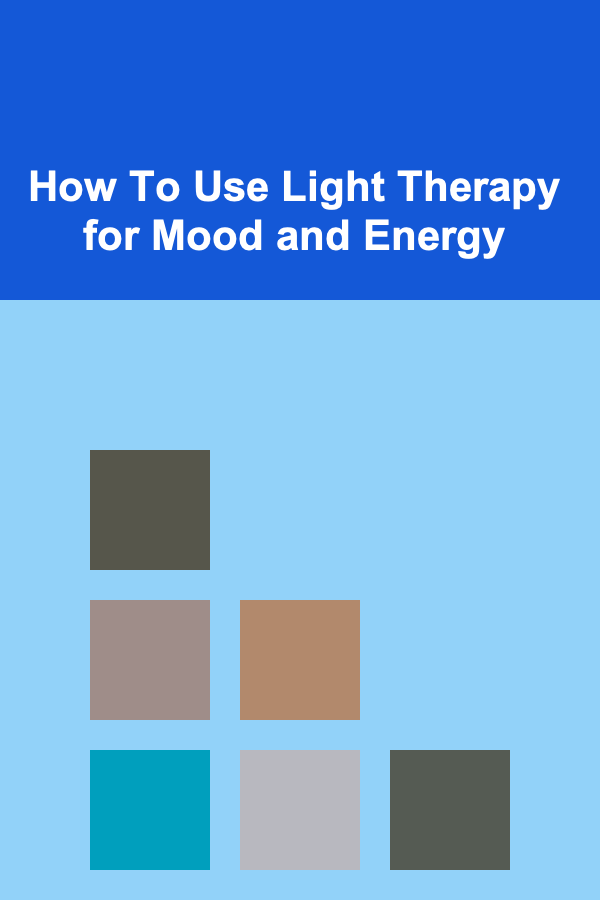
How To Use Light Therapy for Mood and Energy
ebook include PDF & Audio bundle (Micro Guide)
$12.99$8.99
Limited Time Offer! Order within the next:

Light therapy has gained significant recognition as a natural and effective treatment for various mood and energy-related conditions. From Seasonal Affective Disorder (SAD) to general fatigue and depression, light therapy offers a non-invasive, drug-free solution. This article explores the science behind light therapy, its therapeutic applications, and how you can use it to boost mood and energy levels effectively.
Understanding Light Therapy
Light therapy, often referred to as phototherapy, involves exposure to artificial light that mimics natural sunlight. It is primarily used to treat disorders related to mood, energy levels, and circadian rhythm disruptions. The light used in therapy is typically much brighter than ordinary indoor lighting, with an intensity of 10,000 lux being standard for treatment.
The key to light therapy's effectiveness lies in its ability to regulate the body's internal clock, or circadian rhythm, which influences sleep, mood, and overall well-being. By using light to mimic the natural daylight cycle, individuals can improve their mood, sleep quality, and energy levels, especially during the darker months or when faced with irregular sleep patterns.
The Science Behind Light Therapy
To understand why light therapy works, it's essential to explore how our bodies respond to light. The human body's internal clock, also known as the circadian rhythm, is regulated by an area in the brain called the suprachiasmatic nucleus (SCN). This part of the brain is highly sensitive to light, particularly the blue wavelengths found in sunlight.
When exposed to light, the SCN sends signals that influence the production of melatonin, a hormone that regulates sleep. During the day, exposure to natural light suppresses melatonin production, keeping you awake and alert. In the evening, the absence of light encourages melatonin release, signaling to the body that it's time to sleep.
For individuals with mood disorders, such as depression or anxiety, or those struggling with energy levels, these natural cycles can become disrupted. Light therapy helps reset these biological rhythms, especially in cases of Seasonal Affective Disorder (SAD), where the lack of sunlight during the winter months exacerbates symptoms of depression and lethargy.
Applications of Light Therapy
1. Seasonal Affective Disorder (SAD)
SAD is a form of depression that occurs at certain times of the year, typically during the fall and winter months when sunlight is less abundant. It is characterized by symptoms such as low energy, irritability, oversleeping, weight gain, and feelings of sadness.
Light therapy is considered one of the most effective treatments for SAD. It is believed to work by mimicking the effects of natural sunlight, which helps regulate the circadian rhythm and boost serotonin levels in the brain. These effects can alleviate the symptoms of SAD and help individuals maintain a more balanced mood throughout the year.
2. Insomnia and Sleep Disorders
Disruptions in the sleep-wake cycle are a common issue for many people, especially in today's modern world, where artificial light and technology often interfere with natural circadian rhythms. Light therapy can be used to reset the body's internal clock, especially for those experiencing insomnia or other sleep disorders.
For individuals with delayed sleep phase disorder (DSPD), for example, light therapy is often used in the morning to help reset their circadian rhythm. By exposing the person to bright light upon waking, light therapy helps signal to the brain that it's time to start the day, making it easier to fall asleep at a normal hour in the evening.
3. Depression and Mood Disorders
Light therapy is not only effective for treating SAD, but it has also shown promise in helping individuals with general depression and other mood disorders. Many studies have found that light therapy can significantly reduce depressive symptoms, particularly for those who experience low mood during the winter months.
One of the mechanisms behind this is the stimulation of serotonin production. Light exposure can boost the production of serotonin, a neurotransmitter that plays a significant role in mood regulation. Additionally, light therapy may enhance the brain's sensitivity to other mood-boosting chemicals like dopamine.
4. Fatigue and Low Energy
For those struggling with chronic fatigue, low energy levels, or those who experience sluggishness and lack of motivation, light therapy can be a powerful tool. Regular exposure to bright light can help increase alertness, improve mood, and regulate sleep patterns, which in turn boosts overall energy.
People who work night shifts or those who suffer from jet lag can benefit from light therapy by aligning their sleep-wake cycle with the natural daylight cycle. Light therapy can help individuals stay alert during the day and feel more energized, while also improving the quality of their sleep at night.
How to Use Light Therapy Effectively
1. Choose the Right Type of Light Box
Light therapy is typically administered using a light box, which is a device that emits a certain intensity of light. When selecting a light box, there are several factors to consider to ensure maximum effectiveness:
- Brightness (Lux): Choose a light box with a brightness of at least 10,000 lux, which is the intensity typically used in clinical studies.
- UV Filter: Ensure that the light box has a UV filter to protect your eyes and skin from potential harm caused by ultraviolet radiation.
- Size and Design: Light boxes come in different sizes and designs. A larger box may offer greater coverage, but it's essential to choose one that fits comfortably into your daily routine.
- Adjustable Settings: Some light boxes offer adjustable settings for brightness and duration, allowing you to personalize your therapy sessions based on your needs.
2. Find the Right Time and Duration
Timing and duration are crucial factors when using light therapy. To achieve the best results, light therapy should be used consistently and at the right time of day.
- Morning Use: Light therapy is most effective when used in the morning, preferably within the first hour after waking up. This helps regulate your circadian rhythm and improves energy levels throughout the day.
- Duration: The typical duration for light therapy sessions is 20 to 30 minutes. However, the exact time may vary depending on the intensity of the light box and individual needs. Some people may need longer sessions to feel the benefits.
- Consistency: For light therapy to be effective, it should be used consistently over several weeks. Most people start noticing improvements within a few days to a week of daily use.
3. Positioning and Distance
The positioning of the light box is also important for effective therapy. The light box should be placed at eye level and positioned about 16 to 24 inches from your face. It should be angled to allow light to enter your eyes indirectly, without staring directly into the light, which could be uncomfortable or damaging.
While using the light box, you can engage in other activities, such as reading, working, or eating breakfast. The goal is to receive indirect exposure to the light, so you don't have to focus on it directly.
4. Monitor Progress and Adjust
It's important to track your progress while using light therapy. Keep an eye on changes in your mood, energy levels, and sleep patterns. If you don't notice any improvements after a few weeks, consider adjusting the duration, timing, or intensity of the therapy sessions.
It's also helpful to maintain a consistent daily routine, including regular exercise, healthy eating habits, and good sleep hygiene. Light therapy works best when integrated into an overall healthy lifestyle.
Precautions and Considerations
While light therapy is generally considered safe, there are a few precautions to keep in mind:
- Eye Sensitivity: If you have any pre-existing eye conditions or if you are sensitive to light, it's important to consult with a healthcare provider before beginning light therapy.
- Medication: Certain medications, such as those that increase photosensitivity, may interact with light therapy. It's crucial to discuss your medications with your doctor before starting treatment.
- Overexposure: While light therapy is beneficial, excessive exposure to bright light can lead to side effects such as eye strain, headaches, or sleep disturbances. It's important to follow the recommended duration and intensity guidelines.
Potential Side Effects
Although rare, some people may experience mild side effects from light therapy, including:
- Headaches: Some individuals may experience headaches after using light therapy, especially if the light intensity is too high.
- Eye Strain: Prolonged exposure to bright light can cause eye strain or discomfort, particularly for those with sensitive eyes.
- Sleep Disturbances: If light therapy is used too late in the day or for too long, it may interfere with sleep patterns, making it harder to fall asleep at night.
Conclusion
Light therapy is a powerful tool for improving mood and boosting energy levels, offering a natural, non-invasive treatment option for conditions such as Seasonal Affective Disorder, depression, insomnia, and chronic fatigue. By understanding the science behind light therapy, choosing the right equipment, and using it consistently, you can harness the benefits of light to enhance your well-being.
As light therapy continues to gain recognition, its applications in mental health care, sleep medicine, and general wellness will likely expand. Whether you're looking to combat the winter blues, improve sleep quality, or simply feel more energized throughout the day, light therapy could be the key to achieving a brighter, more vibrant life.

How to Maintain a Clean Home While Working From Home
Read More
How to Organize Hand Tools for Easy Access
Read More
Top Tips for Saving Money on Car Rental Services
Read More
How To Analyze the Use of Color in Movies
Read More
How to Fly a Drone for Real Estate Photography
Read More
10 Tips for Staying on Track with Your Teacher Planner
Read MoreOther Products

How to Maintain a Clean Home While Working From Home
Read More
How to Organize Hand Tools for Easy Access
Read More
Top Tips for Saving Money on Car Rental Services
Read More
How To Analyze the Use of Color in Movies
Read More
How to Fly a Drone for Real Estate Photography
Read More